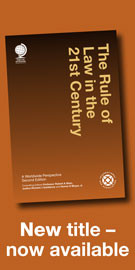Outer space - the final warfaring frontier?
12 July 2019

University of South Africa
In our latest blog, Anel Ferreira-Snyman, Professor, School of Law, University of South Africa and co consulting editor of Outer Space Law, discusses the appropriateness of soft law to provide a framework to prevent the weaponisation of outer space.
Although the race to the moon occupied the space agenda of the two major space powers, the (then) USSR and the USA during the 1960s, the potential use of outer space for military purposes remained intrinsically linked to the development of space technology and space flight since the end of the Second World War. The recent directive by American President, Donald Trump, for the establishment of an independent space force, again highlights the military use of outer space for national security purposes.
Because of the strategic and military importance of space activities for states, some commentators argue that the militarisation of outer space has in fact always been the impetus for reaching outer space. While it could conversely be argued that not all space activities have a purely military purpose, it still holds true that many of these activities at least serve a direct or indirect military interest, specifically in view of the dual-use character of space technologies. At the time of the negotiation of the Outer Space Treaty of 1967, both the USSR and the USA already had military satellites in orbit. Consequently, in contrast with the Antarctic Treaty of 1959 which unequivocally prohibits ‘any measure of a military nature’, article IV of the Outer Space Treaty does not place a clear ban on all military activities in outer space. This presents a number of legal challenges:
- Peaceful purposes
In keeping with the terminology employed by the UN Charter, requiring that states settle their disputes by peaceful means, article IV of the Outer Space Treaty stipulates that outer space shall be used for peaceful purposes exclusively. The term ‘peaceful’ is however not defined in the Treaty, leaving the question open whether it means non-aggressive (as the USA and other Western states argue) or whether it should rather be interpreted as non-military. The fact that the Outer Space treaty allows for the use of military personnel in outer space for scientific research or any peaceful purposes, seems to suggest that the interpretation of ‘peaceful’ as meaning the completely non-military use of outer space, would be too broad for the purposes of the Treaty. Moreover, since the practice of states to use dual-purpose technologies (i.e. communication and remote sensing satellites) in outer space has been generally accepted as lawful, any attempts to prohibit it now would in all probability be a futile exercise.
- Militarisation versus weaponisation
In view of the above, it is clear that a distinction is currently drawn between the militarisation and the weaponisation of outer space. While the so-called passive military use of outer space (such as reconnaissance and surveillance) has been accepted as legal by the large majority of states, the weaponisation of outer space, by targeting space assets using earth- or space-based offensive weaponry, is still regarded as illegal. Thus, rather ironically, the use of satellites to direct air strikes, which is clearly not peaceful action, is accepted by states. Although outer space is currently not weaponised by any state, the performance of anti-satellite tests by states, such as China and the vulnerability of space systems to cyber-attacks, have fostered international fears that the weaponisation of outer space may be a real possibility, with obvious implications for space security. Due to the generation of vast amounts of space debris, the mere testing of space weapons already poses a risk to space security and to the right of other states to use and explore outer space freely. The possible threat that non-state entities pose to space security should also not be overlooked. Even though it is not yet a commonly-predicted threat, it has been cautioned by some commentators that specifically satellite technology is an attractive target for space terrorism, as interference with a state’s satellites could disrupt military operations as well as daily financial and telecommunication activities.
- Space weapons
The term ‘space weapon’ is not defined in any of the current outer space treaties. If a broad approach is followed, a space weapon would be any system capable of destroying or damaging space objects, while a narrow definition would limit a space weapon to any system with the specific purpose of destroying such objects. However, most space equipment has a dual purpose - civilian and military. As a result, most space objects designed to be used for peaceful purposes in outer space, have the potential to become a space weapon. Article IV of the Outer Space Treaty does not mention conventional weapons or any other military systems, but specifically prohibits the placement of nuclear weapons and weapons of mass destruction in orbit around the earth or on celestial bodies. It is therefore not clear whether the use of conventional weapons in outer space is implicitly permitted. Consequently, some commentators argue that the use of conventional weapons for peace-keeping purposes in terms of articles VI and VII of the UN Charter, would be permissible under article IV of the Outer Space Treaty. It is furthermore widely accepted that the use of military support systems and nuclear power sources are not in contravention of the Treaty. However, ballistic missile defence shields developed by states, such as the USA, to defend itself against missile attacks, is more contentious, since the technology could potentially be used as anti-satellite weapons.
What would be the way forward? Although most states are (theoretically) in agreement that the weaponisation of outer space should be prevented, all attempts to conclude a binding treaty has been very challenging. Both the 2008 and 2014 versions of the Russia/China Draft Treaty on the Prevention of the Placement of Weapons in Outer Space and of the Threat or Use of Force against Outer Space Objects were rejected by the USA. Due to the difficulties in creating a binding treaty, the appropriateness of soft law to prevent the weaponisation of outer space must be considered. It could be argued that soft law rules will have a moral and political value, as there is an expectation that states would comply with it. Especially in instances where there is an urgent need for legal clarity, as in the current instance, a soft-law instrument (in the form of guidelines, codes of conduct or transparency and confidence-building measures) can be negotiated in a relatively short period of time and implemented immediately, without the need for ratification by states. Soft law also has a legal value, since it provides the premise for the development of customary international law, which could eventually lead to the conclusion of a binding treaty. The European Union’s Draft Code of Conduct for Outer Space Activities is a good example of an attempt to regulate the military use of outer space by means of a soft-law instrument. The Code, which will not be legally binding, aims to provide safety and security in outer space by means of voluntary agreed upon principles and guidelines. Although it is agreed with the proponents of a hard-law approach, that a legally binding treaty should be adopted to regulate the military use of outer space, it is submitted that as an interim measure, soft law guidelines should in the meantime be developed to provide a framework for the eventual creation of a consolidated and binding legal instrument. It is therefore imperative that an international dialogue on the military use of space is facilitated under the auspices of the United Nations Committee for the Peaceful Uses of Outer Space to address the legal uncertainties that might impair the peaceful use of outer space.
Anel Ferreira-Snyman, Professor, School of Law, University of South Africa and co consulting editor of Outer Space Law: Legal Policy and Practice.













Any comments - send us an email